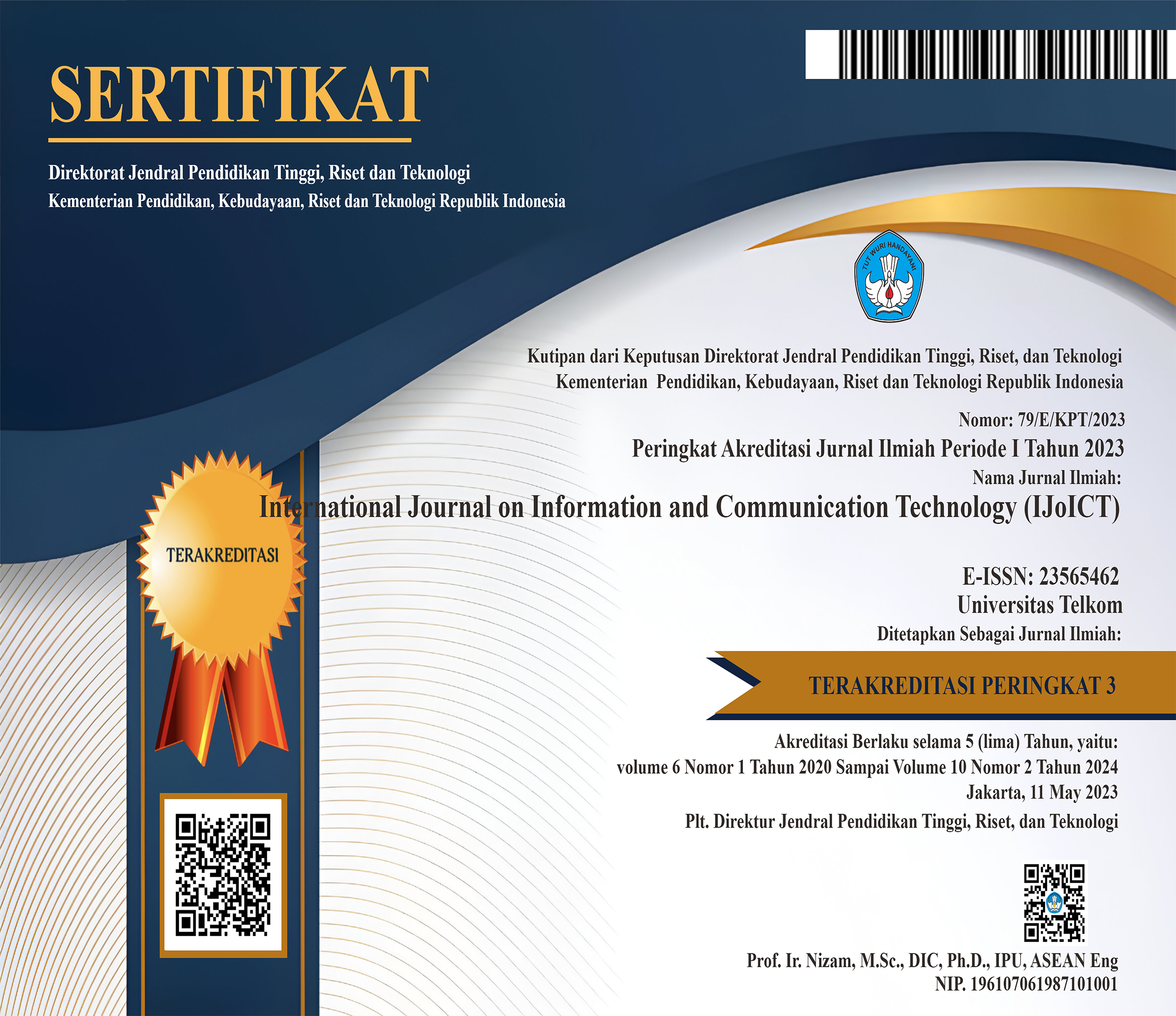Classification of Dengue Hemorrhagic Fever (DHF) Spread in Bandung using Hybrid Naïve Bayes, K-Nearest Neighbor, and Artificial Neural Network Methods
 Abstract views: 663
,
Abstract views: 663
,
 pdf downloads: 401
pdf downloads: 401
Abstract
Dengue fever is a dangerous disease caused by the dengue virus. One of the factors causing dengue fever is due to the place where you live in the tropics, so that cases of dengue fever in Indonesia, especially in the Bandung Regency area, will continue to show high numbers. Therefore, information is needed on the spread of this disease by requiring the accuracy and speed of diagnosis as early prevention. In terms of compiling this information, classification techniques can be done using a combination of methods Naïve Bayes, K-Nearest Neighbor(KNN), and Artificial Neural Network(ANN) to build predictions of the classification of dengue fever, and the data used in this Final Project are dataset affected by the spread of dengue fever in Bandung regency in the 2012-2018 period. The hybrid classifier results can improve accuracy with the voting method with an accuracy level of 90% in the classification of dengue fever.
Downloads
References
[2] Dinas Kesehatan.2018.Profil Kesehatan Kabupaten Bandung Tahun 2018.Bandung : Dinas Kesehatan Kabupaten Bandung.
[3] Suciati, S., Mujiati, I., Ayu, D., Ristianah, V., & Lestari, W. A. (2016). PENERAPAN ALGORITME J48 UNTUK PREDIKSI PENYAKIT DEMAM BERDARAH. Telematika, 9(2), 1-10.
[4] Sari, P. P. M. K., Ernawati, E., & Pranowo, P. (2015). Kombinasi Metode K-Nearest Neighbor dan Naive Bayes Untuk Klasifikasi Data. J. SEMNASTEKNIMEDIA, 3, 37-41.
[5] Mandiri, D. R. S. N. (2017). Komparasi Algoritma Neural Network, K-Nearest Neighbor Dan Naive Baiyes Untuk Memprediksi Pendonor Darah Potensial. Speed-Sentra Penelitian Engineering dan Edukasi, 8(3).
[6] Vembandasamy, K., Sasipriya, R., & Deepa, E. (2015). Heart diseases detection using Naive Bayes algorithm. International Journal of Innovative Science, Engineering & Technology, 2(9), 441-444
[7] Assaghir, Z., Janbain, A., Makki, S., Kurdi, M., & Karam, R. (2017). Using neural network to predict the hypertension. International Journal of Science & Engineering Development Research. Accepted January.
[8] Taneja, P., & Gautam, N. (2019). Hybrid Classification Method for Dengue Prediction. International Journal of Engineering and Advanced Technology (IJEAT) ISSN, 2249-8958.
[9] Santosa, B., & Umam, A. (2018). Data Mining dan Big Data Analytics: Teori dan Implementasi Menggunakan Python & Apache Spark. Yogyakarta: Penebar Media Pustaka.
[10] Kusrini, E. T. L. (2009). Algoritma data mining. Yogyakarta: Andi Offset.
[11] Wanto, A., Siregar, M. N. H., Windarto, A. P., Hartama, D., Ginantra, N.L. W. S. R., Napitupulu, D., ... & Prianto, C. (2020). Data Mining: Algoritma dan Implementasi. Yayasan Kita Menulis.
[12] Watratan, A. F., & Moeis, D. (2020). Implementasi Algoritma Naïve Bayes Untuk Memprediksi Tingkat Penyebaran Covid-19 Di Indonesia. Journal of Applied Computer Science and Technology, 1(1), 7-14.
[13] Rini, D. C., Farida, Y., & Puspitasari, D. (2016). Klasifikasi Menggunakan Metode Hybrid Bayessian-Neural Network (Studi Kasus: Identifikasi Virus Komputer). Jurnal Matematika" MANTIK", 1(2), 38-43.
[14] Fadlan, C., Ningsih, S., & Windarto, A. P. (2018). Penerapan Metode Naïve Bayes Dalam Klasifikasi Kelayakan Keluarga Penerima Beras Rastra. JUTIM (Jurnal Teknik Informatika Musirawas), 3(1), 1-8.
[15] Wanto, A., Siregar, M. N. H., Windarto, A. P., Hartama, D., Ginantra, N.L. W. S. R., Napitupulu, D., ... & Prianto, C. (2020). Data Mining: Algoritma dan Implementasi. Yayasan Kita Menulis.
[16] Prasetyo, E. (2012). Fuzzy K-Nearest Neighbor in Every Class Untuk Klasifikasi Data. In Seminar Nasional Teknik Informatika (No. Santika, pp. 57-60).
[17] Asfaw, (2019). T. Performance Comparison of K-Nearest Neighbors and Gaussian Naïve Bayes algorithms for Heart Disease Prediction. International Journal of engineering Science Invention(IJESI). Vol. 8 Issue 08 Series.I.
[18] Santoso, B., & Azis, A. I. (2020). Machine Learning & Reasoning Fuzzy Logic Algoritma, Manual, Matlab, & Rapid Miner. Yogyakarta: Deepublish

This work is licensed under a Creative Commons Attribution 4.0 International License.
Manuscript submitted to IJoICT has to be an original work of the author(s), contains no element of plagiarism, and has never been published or is not being considered for publication in other journals. Author(s) shall agree to assign all copyright of published article to IJoICT. Requests related to future re-use and re-publication of major or substantial parts of the article must be consulted with the editors of IJoICT.









.png)

.jpg)




